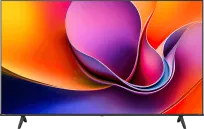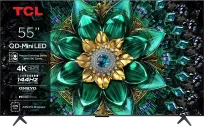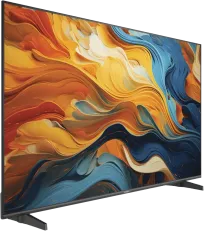
Great colours, very high brightness, and deep, pitch-black darkness. What connects these three features?
It’s definitely that they have nothing to do with the fact that we are talking about a laser projector.
These devices are slowly replacing the well-known lamp projectors, but the marketing of some manufacturers has gone so far that we decided to clarify the issue of lasers.
How does a laser projector work?
What comes to mind when we think of how a laser projector works? It’s possible that we envision a device that shoots a laser beam directly onto the screen and paints an image pixel by pixel. If that were the case, we would achieve all the features we mentioned at the very beginning. Unfortunately, it doesn’t work that way. A far more accurate name is a projector with a laser light source.
This technology replaces the projector’s lamp itself, while the rest of the device remains unchanged.
So in such a projector, we still have an image sensor, processor, and lens and it’s precisely these 3 elements that determine the black level, colours, and especially the sharpness and resolution of the image.
So what do we gain by replacing the traditional lamp with a laser light source?
Blue laser with a luminescent wheel
We can list a few real advantages, but they depend on the type of laser in question.
Currently, there are two solutions on the market. The first is a blue laser with a phosphor wheel. Its principle of operation is similar to that of an LED bulb. The laser beam excites the phosphor and produces white light, which is full-spectrum. In order to obtain colour from it, it must be filtered through a matrix or by a colour wheel in DLP projectors.
This solution does not provide more saturated colours than a classic lamp in a projector. For gamers or film buffs playing 4K content in HDR, we don’t have good news. This laser does not enrich the colour palette, which is so needed in such materials. It also does not eliminate the rainbow effect in DLP projectors, which many users complain about. This manifests as seeing a rainbow behind bright contours. Of course, each of us can have different perceptions regarding this effect, so it's best to test it ourselves to see if it bothers us, even before purchasing a DLP projector.
So, does the laser with a phosphor wheel significantly improve image quality? We must state that unfortunately it does not.
Three-Colour RGB Laser
The second solution uses 3 RGB lasers and this design has a real advantage over the lamp.
This is due to the fact that the waves have a narrow band, so we automatically have a richer colour palette, and the DLP colour wheel is unnecessary, meaning the rainbow effect is less noticeable.
In the case of this solution, we can confidently say that it is a better technology than a lamp, considering the two issues mentioned above. But is the difference really that big?
The improvement of the rainbow effect can be debatable, as lasers might operate faster than the colour wheel, but they don’t have to. In this case, everything depends on the manufacturer.
When it comes to the colour palette, the matter is much more complex.
It must be stated that projectors with a three-colour laser offer us highly saturated colours, which we cannot achieve through traditional methods. However, it should be considered that strong colours are not synonymous with their correct reproduction.
In the case of regular Full HD films, the desired palette is Rec.709
This is provided by almost every technology currently used in home cinema projectors.
When we talk about 4K movies and games in HDR, they use a very wide colour gamut BT.2020, as we see below.
Unfortunately, a large part of the video content available on discs or streaming platforms is limited to the DCI-P3 color gamut, as most film studios operate within this system. To fully (or almost fully) reproduce the capabilities of this gamut, we need a high-quality lamp projector, for example:
Epson EH-TW9400 - 100%
JVC RS540 - 97%
SONY VPL-VW590 - 89%
From what we already know, it’s clear that RGB laser is noticeably better than the classic solution; however, considering the content we play in our homes, this does not relate to a significant gain and jump in quality.
Let’s also remember that the ability to achieve saturated colors has nothing to do with the accuracy of color reproduction or the smoothness of tonal transitions.
They depend on the image sensor and image processor, not on the light source, as we mentioned at the beginning of this article.
What technology does the projector use?
Now that we know two technologies, namely the unhelpful blue laser in terms of image quality and the advanced tricolour RGB, let's see what specific manufacturers can offer us.
HISENSE:
120L9HA - The so-called laser TV, or short throw projector with a screen included. Here we have a clear indication of the use of RGB laser.
100L5HD - Unfortunately, we do not have clear information about the technology used.
Optoma - This manufacturer does not provide such information on their website. It's a bit strange, and we don't see the point in hiding the full specifications. However, our keen editorial eyes have uncovered a clue in the graphic below.
This photo suggests that a simpler solution using a fluorescent wheel is employed here, which is confirmed by the data we collected during calibration at our clients' sites.
Epson also does not share such information, however, from our experience and measurements, it appears that this manufacturer mainly uses a phosphor wheel, similar to Sony and JVC. Nevertheless, the latter two include additional filters that increase colour gamut coverage in the higher models of their products, as well as transducers that do not produce the rainbow effect.
At ViewSonic and Benq, this information is provided directly on the website:
Some manufacturers also offer small projectors that use LED light sources, and this solution is similar to a three-colour laser.
Durability of the laser vs. the lamp
What is the durability of a laser source like? Manufacturers declare 20,000-30,000 hours before brightness drops by half.
This is many times more than classic lamps, which have a lifespan of around 3,000-5,000 hours. In practice, brightness drops after just 1,500 hours, and we know of cases where clients had to replace the lamp after only 1,000 hours of operation.
Unfortunately, we don't have such a research trial for lasers, but among our 2 clients, there has been a situation where the source lost a significant amount of power after just under 3,000 hours. In one case, the issue was resolved under warranty, but in the other case, the entire module was deemed to need replacement, which was priced at...... 20,000 PLN.
As we can see, there is no doubt about the superiority of lasers over lamps in terms of durability, but in case of failure, the cost can make us dizzy.
Replacing a lamp costs 800-1,800 PLN, so the price for 1 hour of viewing ranges from 0.40-0.90 PLN with frequent replacements. Is that a lot? Judge for yourselves.
Power Consumption and Brightness
Let's tackle another statement put forward by laser projector manufacturers, which is lower power consumption while achieving the same brightness as a classic lamp.
It’s hard to verify because there aren't two identical devices that only differ in light source. Nevertheless, if there is such a difference, it probably won't translate into greater savings than a few dollars over a month.
Speaking of brightness, laser projectors are not brighter than their lamp counterparts. The actual brightness hovers around 2000 lumens.
Let's remember that reality brutally confronts the dry data provided by manufacturers. In the case of the well-known company Optoma, the actual brightness can differ by as much as 60% from the data provided in the specifications. We'll write more about this another time :)
Another argument presented when it comes to laser projectors is the lack of need to warm up before use and then cool down after using it.
We can ponder whether this is really a significant factor in choosing a device. Surely, we often don't even notice that noise after turning off a lamp projector. But in this matter, everyone has their choice and opinion :)
Is it worth it?
As you can see, a laser projector is still just an ordinary projector that uses a laser light source instead of a lamp. It doesn’t automatically offer better image quality compared to its classic counterpart, nor does it become an alternative to a television.
When choosing a device, we must pay particular attention to the technology that has been used. A three-colour laser is definitely a better option, providing a richer colour palette and reducing the rainbow effect in DLP projectors.
The biggest advantage of a laser projector is its durability, although, as we can see, there are exceptions.
That doesn’t mean that lamp projectors have become obsolete. On the contrary, they are still good devices, like the EPSON EH-TW9400. In our studio, we also have a classic projector JVC RS540 and we’re not rushing to replace it. This is because changing the image source to laser makes very little difference, or none at all. The main variables in quality are the lens, image sensor, processor, and software.
And which technology do you prefer? What do you use in your home theatres? Share with us in the comments!
 Katarzyna Petru
Katarzyna Petru













